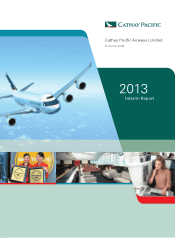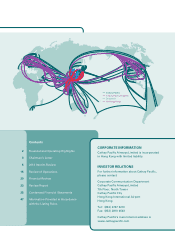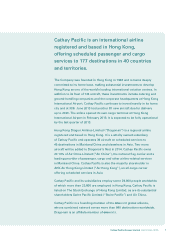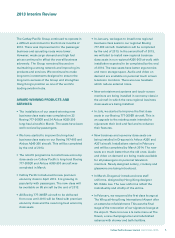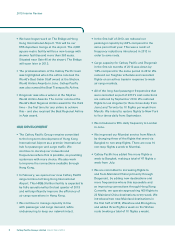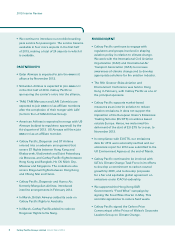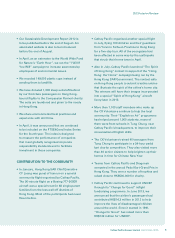Cathay Pacific 2013 Annual Report Download - page 5
Download and view the complete annual report
Please find page 5 of the 2013 Cathay Pacific annual report below. You can navigate through the pages in the report by either clicking on the pages listed below, or by using the keyword search tool below to find specific information within the annual report.
Cathay Pacific Airways Limited Interim Report 2013 3
Chairman’s Letter
The Cathay Pacific Group reported an attributable
profit of HK$24 million for the first six months
of 2013. This compares to a restated loss of
HK$929million in the first half of 2012. Earnings
per share were HK0.6 cents compared to a
restated loss per share of HK23.6 cents in the first
half of 2012. Turnover for the period fell by 0.6%
to HK$48,584million.
The Directors have declared a first interim
dividend of HK$0.06 per share (2012: nil) for the
six months ended 30th June 2013. The interim
dividend which totals HK$236 million (2012: nil)
will be paid on 3rd October 2013.
We continued to operate in a challenging business
environment in the first half of 2013, though there
was improvement in our passenger business.
Demand in the major air cargo markets remained
weak. Our cargo business has been affected by
weak demand for more than two years, which
is unprecedented. The persistently high price
of jet fuel continued to affect our business
adversely. Share of losses from associated
companiesincreased.
In 2012, we introduced measures designed
to protect our business, in particular from the
high price of jet fuel. We changed schedules,
reduced capacity and withdrew older, less fuel-
efficient aircraft from service. The fuel and aircraft
maintenance components of our operating costs in
the first half of 2013 were significantly lower and
financial performance improved as a result. But
we did not allow cost reductions to compromise
our brand or the quality of our service, and we
continued to make major investments in new
aircraft, new products and our new cargo terminal
at Hong Kong International Airport which will
benefit the business in the longterm.
In the first half of 2013 our net fuel costs
decreased by 8.5% compared to the same
period in 2012. Notwithstanding this reduction,
fuel remains the Group’s most significant cost,
accounting for 38.8% of our total operating costs
during the period. Managing the risk associated
with high and volatile fuel prices remains a high
priority. In April 2013 we took advantage of a brief
drop in fuel prices to extend our fuel hedging
into2016.
Our passenger business in the first half of 2013
improved compared to the same period in
2012. Revenue increased by 0.8% to HK$34,978
million, although capacity decreased by 4.8%.
The load factor increased by 1.2 percentage
points to 81.3%. Having fewer seats available
enabled us to improve revenue management.
Yield also improved by 4.4% to HK69.0 cents.
Passenger demand was strong on long-haul
routes in all classes of travel. However, demand
on regional routes did not match the increase in
capacity on these routes, which put yield under
pressure. Travel within the Asia Pacific region was
affected by H7N9 avian flu and political issues in
NortheastAsia.
Our cargo business has been affected by weak
demand since April 2011. There is still no sign
of sustained improvement. The Group’s cargo
revenue for the first half of 2013 was down by 5.2%
to HK$11,278 million compared to the same period
in 2012. Capacity for Cathay Pacific and Dragonair
was down by 1.8%. The load factor was down by
1.9 percentage points to 62.4%. Yield was down by
3.3% to HK$2.33. Capacity was adjusted in line with
demand. We reduced our schedules and made ad
hoc flight cancellations. We carried more cargo in
the bellies of passenger aircraft in order to reduce
costs. Onthe plus side, our new cargo terminal at
Hong Kong International Airport is expected to be
fully operational by the last quarter of 2013, which
will reduce costs and improve efficiency in our
cargobusiness.
In the first six months of 2013 we took delivery
of six new aircraft: two Airbus A330-300 aircraft,
three Boeing 777-300ER aircraft and one Boeing
747-8F freighter. Four Boeing 747-400 passenger
aircraft were retired during the period. In March
2013, we entered into agreements in relation to
our cargo fleet as part of a package of transactions
among The Boeing Company, Cathay Pacific, Air
China Cargo Co., Ltd. (“Air China Cargo”) and
Air China. Under these transactions, we agreed

